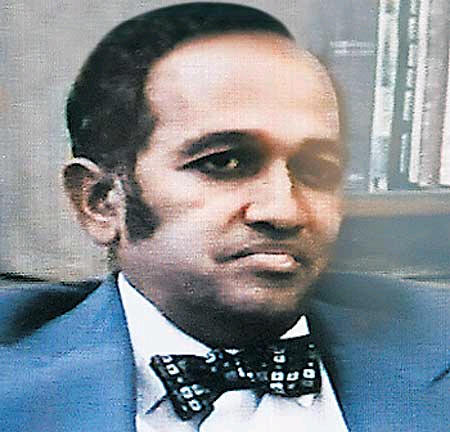
Girls drugged by a doctor in a care home are now having disabled babies

Girls in his care were given pills designed for schizophrenics, psychotics and Parkinson’s sufferers…without having been diagnosed with any of these conditions and often held down and forced to take them.
Nearly 30 years later, the children of girls in his care have learning difficulties, cleft palates, water on the brain and brain growths.
One of the women, Teresa Cooper, 41, said: “They turned us into zombies with those drugs. But we’re only just starting to find out that it may have affected our children as well.”

During 15 years as consultant psychiatrist to Kendall House – run for girls with problems by the Church of England’s Council for Social Responsibility in Gravesend, Kent – Dr Perinpanayagam wrongly prescribed girls drugs.
Valium was given at four times the recommended dose for an adult male. When his methods were exposed on TV it caused outrage although it seems no action was taken.
Despite having no mental health problems or history of violence, daily logs written by staff show Teresa was on a dozen drugs without any diagnosis.
And workers pinned her down to force her to take them – with other children forced to help. The brutal regime at the house is similar to the notorious “pin down” system of discipline used at the same time in Staffordshire children’s homes.
Now – 25 years on – one of Teresa’s sons was blind until the age of two and has learning difficulties. Another has unexplained lumps on his lymph nodes. And her daughter has a cleft palate and Pierre Robin Syndrome, a facial abnormality.
But, after she published a book called Trust No One about her time in Kendall House, other women who were administered drugs at the home got in touch with Teresa – and many of them also have children with abnormalities and disabilities.
She said: “Eight out of the 10 women I am in touch with have had problems like these – and the two who didn’t were not on drugs. It’s too much of a coincidence. Dr Perinpanayagam must have treated over 200 women during his 15 years working for Kendall House, so God knows how many more are out there who I don’t know about.”
Last night an expert on birth defects said drugs could influence future children, even if the victim was not pregnant at the time. Betty Mekdeci, director of Birth Defect Research for Children, said: “High doses at a certain age can have permanent consequences.”
Dr Perinpanayagam, who described himself on his notepaper as “Psychotherapist to the Home Office”, died in 1988. In 1977 he wrote to a medical journal to describe his experiments with tranquillisers on girls in an unnamed “secure home”.
Teresa said she believes he was trying out drugs to invent a way of treating problem children and make a name for himself. She said: “It is terrifying to think how many children’s lives his actions could now have affected.”
Walthamstow MP Neil Gerrard stood up in the Commons 14 years ago to attack the Church of England over the drug regime at Kendall House, which closed in 1986. Last night he said: “If the link between the drugs and these children’s conditions is proved, there must be an official investigation.”
If you were drugged at Kendall House and think it has affected your children call us in confidence on 020 7293 2232.
Pill doc turned teens into zombies
In 1980, Dr Mahenthiran Perinpanayagam’s massive doses of drugs at Kendall House first came to light.
A television documentary quoted another doctor saying he thought one girl’s prescription must have been a misprint.
Meanwhile, Radio 4′s Professor Laurie Taylor co-wrote a book describing how girls at Kendall House had been “reduced to zombies” by the drugs they were given – often without a diagnosis.
By 1984 a report into the home by the Department of Health and Social Security was scathing about the drugs given to the girls.
Inspector Dr Dorothy Black said she was “extremely concerned” about “storage, monitoring and administration of psychotropic drugs”.
She wrote: “The home needs close and urgent attention.”
Two years later Kendall House closed.
Tot’s birth defect
As a frightened 13-year-old, Jules (left) was given huge doses of Valium and other drugs in Kendall House.
Her son was born with a life-threatening birth defect. Jules said: “He has a cyst on his brain’s temporal lobe. He has a crater the width of a golf ball on his head. I didn’t think this had anything to do with Kendall House until I heard about other children.”
Trapped & drugged
“Lisa” Remembers being sent to the “timeout room” – a tiny room with bars on the windows and a lock on the door. There, she was given massive doses of drugs.
She said: “My 16-year-old daughter was born with hydrocephalus. She also has heart problems and neurofibromatosis – little tumours on her nerve endings.
“It’s always been in the back of my mind that all the crap they gave me was the cause of my daughter’s problems.”
We want answers
“Sarah” Believes a string of problems with her two sons are down to the drugs she was given at Kendall House.
She was held down and given injections of Haloperidol and up to 120g of Valium a day. Now her oldest son is dyslexic, with learning difficulties and behavioural problems. And her youngest son has been diagnosed with dyspraxia and dyslexia, and may have Asperger syndrome.
She said: “We all want answers.”
Wasted memories
“Claire” Spent three years in Kendall House in the late 1970s, where records show she was given drugs including antipsychotic Sparine.
She said: “I was like a zombie for a lot of the time, and a lot of my memories have gone. And all my memories before Kendall House have gone.
“When my daughter was born, she had hypermobility syndrome, which is a genetic disease that affects the joints.”